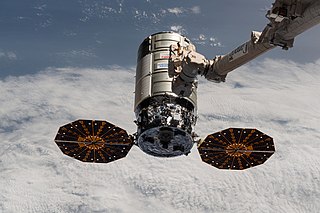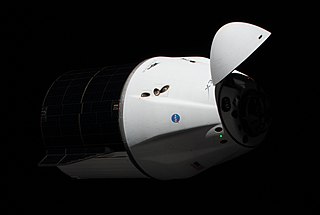Related Research Articles

The International Space Station (ISS) is the largest modular space station currently in low Earth orbit. It is a multinational collaborative project involving five participating space agencies: NASA, Roscosmos (Russia), JAXA (Japan), ESA (Europe), and CSA (Canada). The ownership and use of the space station is established by intergovernmental treaties and agreements. The station serves as a microgravity and space environment research laboratory in which scientific research is conducted in astrobiology, astronomy, meteorology, physics, and other fields. The ISS is suited for testing the spacecraft systems and equipment required for possible future long-duration missions to the Moon and Mars.

Robert Brent "Bob" Thirsk, is a Canadian engineer and physician, and a former Canadian Space Agency astronaut. He holds the Canadian record for the most time spent in space. He became an officer of the Order of Canada (OC) in 2013 and was named to the Order of British Columbia (OBC) in 2012.

Damien High School is an all-male Roman Catholic high school in La Verne, in the U.S. state of California named for Saint Damien of Molokai. The school had its first graduating class in 1963. Each of Damien's freshmen classes draws from an average of over 75 different elementary and junior high schools for youths from Los Angeles and San Bernardino counties. It is located in the Roman Catholic Archdiocese of Los Angeles. It is a part of the tri-school community including St. Lucy's Priory High School and Pomona Catholic High School.

Thomas Henry Marshburn is an American physician and a NASA astronaut. He is a veteran of three spaceflights to the International Space Station and holds the record for the oldest person to perform a spacewalk at 61 years old.

The National Aeronautics and Space Administration is an independent agency of the US federal government responsible for the civil space program, aeronautics research, and space research.

Transmountain Early College High School, commonly referred to as TMECHS, is the Early College High School for the El Paso Independent School District. TMECHS participates in the STEM School program, and through collaboration with EPCC, allows students to take courses at its Transmountain Campus and receive an Associate degree before their high school graduation. It has also collaborated with the University of Texas at El Paso to allow its advanced students to attend UTEP courses in their senior year upon the early completion of their associate degree. All TMECHS students graduate under the Texas Distinguished Achievement Plan, which requires that they conduct original research under the guidance of professionals in their field. Its students are representative of all geographic areas of the city. A lottery and interview process are used to select the 125 student freshman class each year since 2008.
ELIPS - European Programme for Life and Physical Sciences in Space and applications utilising the International Space Station started in 2001 and was intended to cover the activities for the following 5 years. This Microgravity Programme at the European Space Agency (ESA) is an optional programme, with currently 17 ESA member states participating. The ELIPS programme prepares and performs research on the International Space Station, and other unmanned mission platforms like Sounding Rockets, in fundamental and applied life and physical sciences. ELIPS is the continuation of the earlier European microgravity programmes EMIR 1&2, and the Microgravity Facilities for Columbus, MFC.
The NASA Authorization Act of 2010 is a U.S. law authorizing NASA appropriations for fiscal years 2011, 2012, 2013 with the same top-line budget values as requested by US President Barack Obama. It resulted from the Augustine Commission's review of then-current crewed space flight plans.

The NASA Launch Services Program (LSP) is responsible for procurement of launch services for NASA uncrewed missions and oversight of launch integration and launch preparation activity, providing added quality and mission assurance to meet program objectives. LSP operates under the NASA Space Operations Mission Directorate (SOMD).

Orbital-1, also known as Orb-1, was the second flight of the Orbital Sciences Cygnus cargo spacecraft, its second flight to the International Space Station (ISS) and the third launch of the company's Antares launch vehicle. The mission launched on 9 January 2014 at 18:07:05 UTC.

Nanoracks LLC is a private in-space services companywhich builds space hardware and in-space repurposing tools.The company also facilitates experiments and launches of CubeSats to Low Earth Orbit.
The Center for the Advancement of Science in Space (CASIS), a non-profit organization, is the manager of the International Space Station United States National Laboratory, a US government-funded laboratory with principal research facilities located in the United States Orbital Segment of the International Space Station (ISS).
Garatéa-L is a space probe planned by the Brazilian company Airvantis with the support of institutions such as INPE, IMT, ITA, LNLS/CNPEM, PUC-RS, UFSC, USP and USRA. It will be the first Brazilian mission in deep space, as well as the first directed to the Moon. The CubeSat will be launched by an Indian rocket PSLV-C11 as part of the Pathfinder mission, which will pioneer deep space commercial exploration through a partnership between British private companies with the UK Space Agency (UKSA) and the European Space Agency (ESA).

SpaceX CRS-21, also known as SpX-21, was a Commercial Resupply Service mission to the International Space Station which launched on 6 December 2020. The mission was contracted by NASA and was flown by SpaceX using a Cargo Dragon 2. This was the first flight for SpaceX under NASA's CRS Phase 2 contract awarded in January 2016. This was also the first Cargo Dragon of the new Dragon 2 variant, as well as the first Cargo Dragon flight that was docked at the same time as a Crew Dragon spacecraft. This mission used Booster B1058.4, becoming the first NASA mission to reuse a booster previously used on a non-NASA mission. This was also first time SpaceX launched a NASA payload on a booster with more than one previous flight.

NG-14, previously known as OA-14, was the fifteenth flight of the Northrop Grumman robotic resupply spacecraft Cygnus and its fourteenth flight to the International Space Station under the Commercial Resupply Services (CRS-1) contract with NASA. The mission was launched on 3 October 2020, at 01:16:14 UTC.

SpaceX CRS-22, also known as SpX-22, was a Commercial Resupply Services (CRS) mission to the International Space Station (ISS) that launched at 17:29:15 UTC on 3 June 2021. The mission is contracted by NASA and is flown by SpaceX using a Cargo Dragon 2. This is the second flight for SpaceX under NASA's CRS Phase 2 contract awarded in January 2016.

SpaceX CRS-23, also known as SpX-23, was a Commercial Resupply Service mission to the International Space Station, successfully launched on 29 August 2021 and docking the following day. The mission was contracted by NASA and was flown by SpaceX using the Cargo Dragon C208. This was the third flight for SpaceX under NASA's CRS Phase 2 contract awarded in January 2016. It was the second mission for this reusable capsule.

SpaceX CRS-24, also known as SpX-24, was a Commercial Resupply Service mission to the International Space Station launched on 21 December 2021, at 10:07:08 UTC. The mission is contracted by NASA and is flown by SpaceX using a Cargo Dragon. This is the fourth flight for SpaceX under NASA's CRS Phase 2 contract awarded in January 2016.

SpaceX CRS-26, also known as SpX-26, is a Commercial Resupply Service mission to the International Space Station (ISS) launched on 26 November 2022. The mission is contracted by NASA and is flown by SpaceX using a Cargo Dragon. This is the sixth flight for SpaceX under NASA's CRS Phase 2 contract awarded in January 2016.
SpaceX CRS-27, also known as SpX-27, is a Commercial Resupply Service mission to the International Space Station (ISS) scheduled to be launched in January 2023. The mission is contracted by NASA and will be flown by SpaceX using a Cargo Dragon. This will be the seventh flight for SpaceX under NASA's CRS Phase 2.
References
- ↑ "Key Individuals". ssep.ncesse.org. National Center for Earth and Space Science Education.
- ↑ "Student Spaceflight Experiments Program". ncesse.org. National Center for Earth and Space Science Education. 30 October 2012.
- 1 2 3 Gaskill, Melissa (6 August 2014). "Student Scientists Present Unexpected Results from Space Station Research". Space Station: Research & Technology. NASA.
- ↑ "Student Spaceflight Experiments Program – Mission 6 to the International Space Station". spaceref.com. SpaceRef Interactive Inc. 30 October 2013.
- ↑ "SSEP in the News". Student Spaceflight Experiments Program Community Network Hubsite. National Center for Earth and Space Science Education.
- 1 2 Goldstein, Jeff (21 April 2014). "New Flight Opportunity for School Districts: Announcing Student Spaceflight Experiments Program (SSEP) Mission 7 to the International Space Station for 2014-15 Academic Year". ncesse.org. National Center for Earth and Space Science Education.
- ↑ "New Flight Opportunity for School Districts: Announcing Student Spaceflight Experiments Program (SSEP) Mission 13 to the International Space Station, Starting September 2018". Student Spaceflight Experiments Program. Retrieved 2 April 2018.
- ↑ "Experiments Selected for Flight". Student Spaceflight Experiments Program Community Network Hubsite. National Center for Earth and Space Science Education.
- ↑ Bever, Lindsey (29 October 2014). "Students lost science experiments in Antares explosion". The Washington Post. Retrieved 31 October 2014.
- ↑ ssep.ncesse.org/current-flight-opportunities/ssep-mission-13-to-the-international-space-station-iss/
- ↑ ssep.ncesse.org/current-flight-opportunities/ssep-mission-14-to-the-international-space-station-iss/
- ↑ ssep.ncesse.org/current-flight-opportunities/ssep-mission-14-to-the-international-space-station-iss/
- ↑ ssep.ncesse.org/current-flight-opportunities/ssep-mission-15-to-the-international-space-station-iss/
- ↑ ssep.ncesse.org/current-flight-opportunities/ssep-mission-14-to-the-international-space-station-iss/
- ↑ ssep.ncesse.org/current-flight-opportunities/ssep-mission-15-to-the-international-space-station-iss/
- ↑ ssep.ncesse.org/current-flight-opportunities/ssep-mission-16-to-the-international-space-station-iss/
- ↑ "The Flight Experiment Design Competition". ncesse.org. National Center for Earth and Space Science Education.
- ↑ "Selected Experiments on SSEP Mission 4 to ISS". Student Spaceflight Experiments Program Community Network Hubsite. National Center for Earth and Space Science Education.
- ↑ "Selected Experiments on SSEP Mission 5 to ISS". Student Spaceflight Experiments Program Community Network Hubsite. National Center for Earth and Space Science Education.
- ↑ "Selected Experiments on SSEP Mission 6 to ISS". Student Spaceflight Experiments Program Community Network Hubsite. National Center for Earth and Space Science Education.
- ↑ "SSEP Program costs". ncesse.org. National Center for Earth and Space Science Education.
- ↑ Grove, Tim (26 April 2013). "An Out-of-This-World Program". nasm.si.edu. Smithsonian National Air and Space Museum.